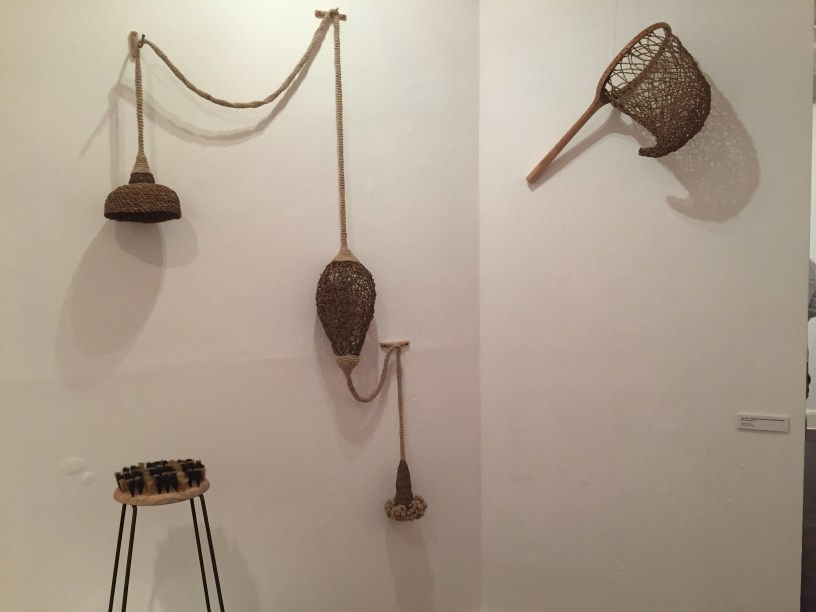What are we close to? What are we distant from? How do proximity and distance affect our bodies, our emotions, our energies and frustrations, our culture and identity?
Distance is an adventure and also a tyranny; intimacy is a delight and also a risk.
In regional arts, planning and infrastructure we often speak – as the curators do here – of accessibility and remoteness. The ARIA index. Inner metro, outer metro, inner regional, outer regional, and remote. To speak of cultural advantage as proximity or distance to the essential services concentrated in capital cities is already to set a measure of disadvantage. To speak instead of connection to country, cultural identity and community of practice is instead to introduce a rigour that orients us to the work.
So I’m not going to speak about proximity and distance in terms of advantage and disadvantage, but rather, in terms of what each of these works is doing to draw us in – or push us away.
The children who seize our gaze in Natalie Grono’s work direct our attention very strongly to these questions. There, far from us, beyond a town, the landscape burns. Here, in the foreground, three children stand in quite complex and ambiguous poses that somehow convey both innocence and culpability. The myth of childhood innocence we all know as the constitutive lie that creates the distance we need from instincts that are always closer than we think.
Faces, eyes, bodies draw us in across all of these works. The patient but wary wisdom in Penny Evans’ masks, the abstract walking forms in the ecosystem proposed by Skye Baker, the muted memories of Amber Wallis, the public hanging of Stephen Garrett – each of these works deploys the human form as both a distancing and an intimating gesture. The form is both familiar and unfamiliar, located and dislocated, present and absent and then present again in a new way.
Intimacy transforms both distance and proximity by creating a change in state. In an intimate encounter – whether its object be far away or very, very close – a kind of transgression happens. We’re touched by what we can’t yet touch ourselves. Distance is collapsed; space vanishes but also time, so that we experience the duration of an extended moment.
What happens in that moment? That only ever tentative sense that everything’s going to be ok comes through in Robert Moore’s text landscape, Charlotte Haywood’s deconstructed AOKs, or Jenny Kitchener’s DNA strands and totemic motherboards. Proximity and distance are expressed here as the durations effected by myth, colonisation and technology – forces that affect space and time in powerful ways.
Amanda Bromfield gives that sense of duration a very present, a visceral sense. Delicate but actually quite practical underpants are crafted in ceramic, their clean and permanent scrunch both a feminine reality and a feminist recognition of that awkward recurrence of blood flow.
Rich blood also in Ben Crawford’s work No Gold Digger – the deep red landscape reminding us that country too can bleed if we don’t nurture it so that it can protect us into the future. Kylie Caldewell’s Bloodlines weave precisely these tensions into her stunning pieces, reminding us that knowledge takes many forms.
Traditional knowledge and its contemporary approaches become ever more important to us as we work harder and harder to reduce the impacts of power imbalance on our health, education, human rights, culture and environment. Both craft as a discipline and the act of making are active challenges to the exercise of that power. Helle Jorgensen’s Lofty Thought Generator and Processor invites just that, while Kat Shapiro-Wood abstracts that thinking into quite solid provocations.
Both Kathryn Dolby and Michael Cusack offer gentle, yet dislocating shapes and colours to shift us from the present to the in-between, while Karla Dickens’ dark room of black artefacts – the weight of the human child, the Piccaninny floor polish, the Work Horse – presents us with a heavy set of tools for weighing up cultural responsibility. Just like the tools she offered us this morning – to think seriously about culture, trauma, grief and resilience… putting the professional artist’s hat on to transform and occupy that other space.
Mahala Magins abstracts the landscape right away, while Jessica O’Connor plunges us deeply into volcanic time, inviting us to understand human trauma, resilience and survival at the scale of tectonic duration. Time itself can be much deeper and much longer than we think.
Christine Willcocks makes all of this devastatingly clear. Her enigmatic forms are given narrative qualities as they gesture toward landscape, but also, quantitative elements as they gesture toward the neatly measurable. Is this a representation of space, or time? Is it dangerous, or inert? If we move closer, will we see more? Or will our understanding be improved if we instead take a step back? A Vulnerable Surface is a rich context for contemplating what’s both closer and further from what we think.
The exhibition is open – enjoy – come back and enjoy in quiet time – enjoy the rest of the Artstate Lismore program.
We’re Closer Than You Think
Curated by Natalie Bull and Zoe Robinson-Kennedy
Commissioned for the Artstate Lismore Arts Program 30 November to 3 December 2017
Presented as the exhibition’s opening talk on 1 December 2017.
Some of the artists featured in this exhibition are Members of NAVA.
IMAGE: Helle Jorgensen The Lofty Thought Generator and Processor (2017)
